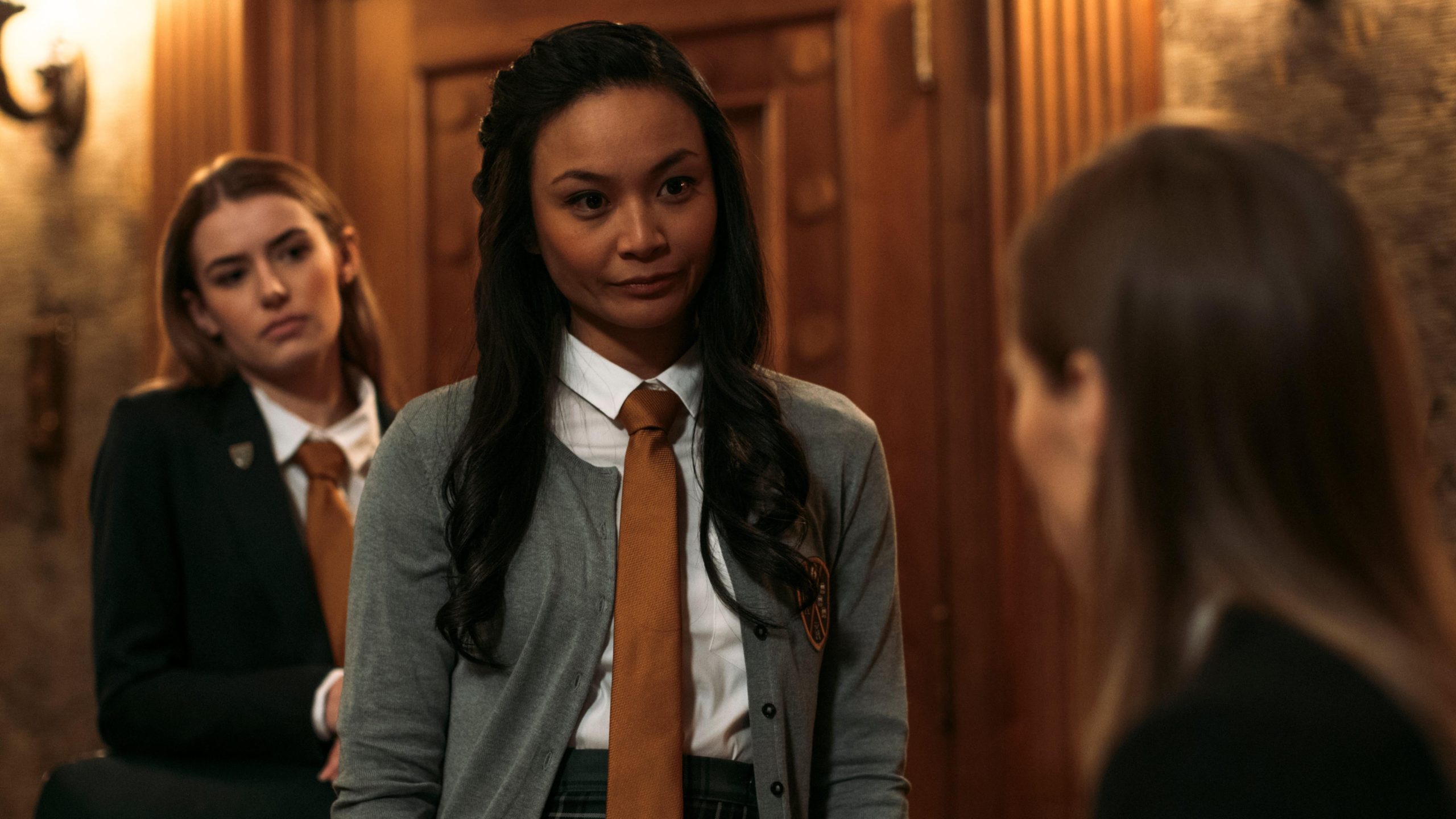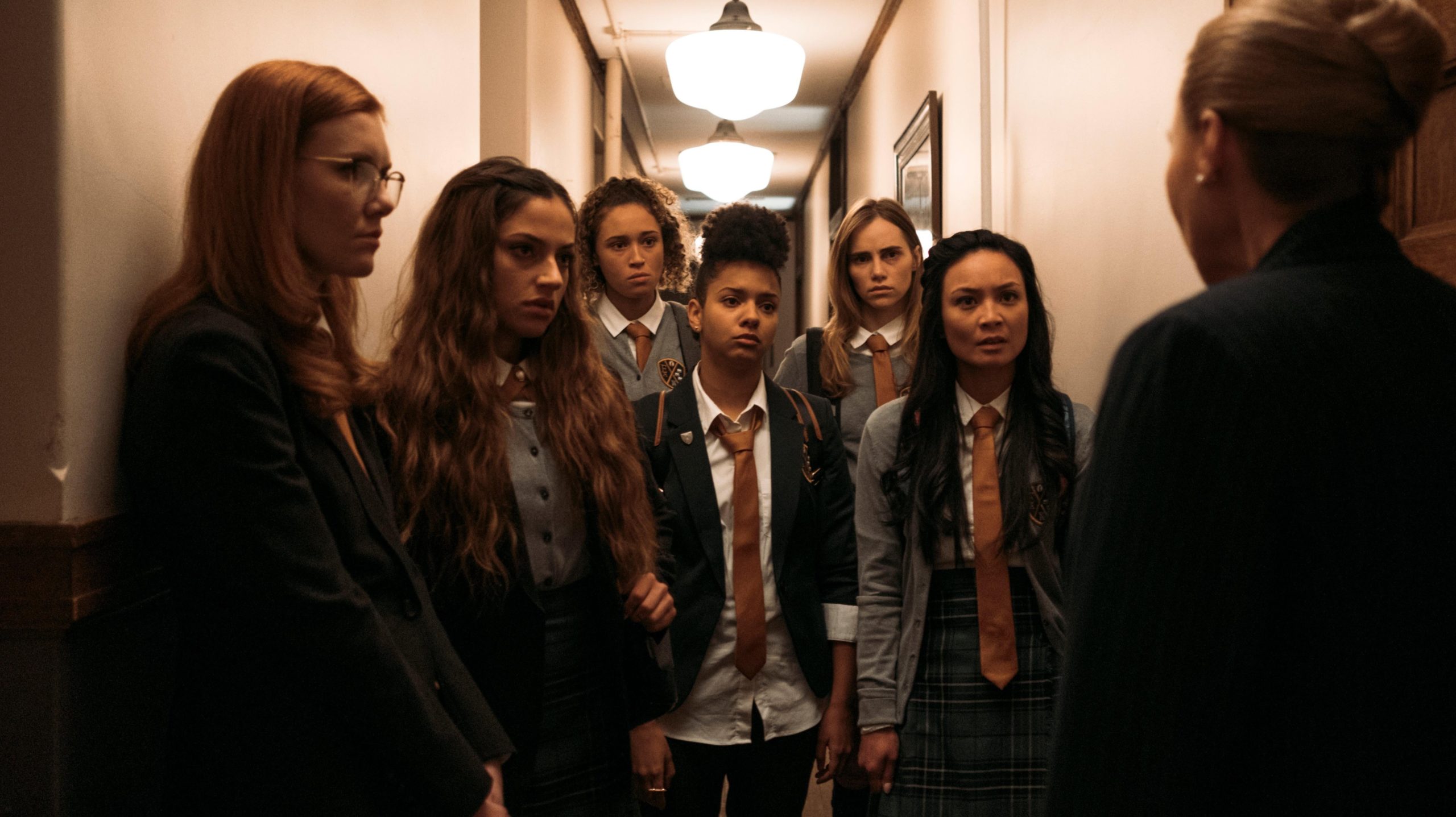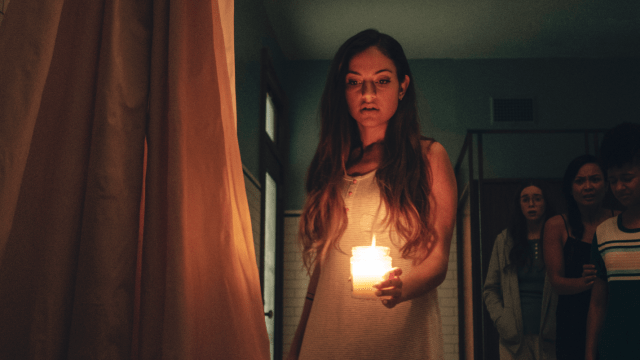Seance — a ghostly thriller about a boarding school that starts racking up a body count soon after a mysterious new student (Suki Waterhouse) arrives — doesn’t end up being the movie you think it’s going to be based on its premise; it has layers while also feeling like an homage to horror films from decades ago. To learn more about how Seance came to be, Gizmodo went to the source: writer-director Simon Barrett (whose previous scripts include You’re Next, The Guest, and Blair Witch), who spoke with us about his writing process, his love of “old-fashioned” horror, and what it’s like trying to make a scary movie in a time when the real world is terrifying as hell.
Cheryl Eddy, Gizmodo: You’re known for writing a lot of horror scripts, but Seance is your feature directorial debut. Was that something you were always building toward, and how did that transition into writing and directing come about?
Simon Barrett: I’d always wanted to direct, but the honest story is that the first feature script that I wrote that I thought I was going to direct myself was Dead Birds, which premiered at the Toronto [Film Festival] back in 2004. I ended up selling that script to a studio through a friend from a film school, just kind of a random connection, and they wanted a real director to direct it, so they brought in Alex Turner — and that was my career for basically the next 15 years or so.
And it was a very good one, I was lucky to have it, and I was very aware of that because being a screenwriter was a lot better than the other jobs I was doing at the time. So I was very happy, especially working with Adam Wingard on lower-budget projects, where I was able to be more collaborative in the physical filmmaking process, following the film through every stage in a way that the average screenwriter doesn’t because I was producing those movies.
But as the budgets got bigger, and particularly on The Guest — that was the first time I really realised that I was becoming, like, just a screenwriter and less utility on Adam’s set, because there just wasn’t much for me to do now that we had healthy budgets. And so I started thinking then, “OK, now it’s time for me to start pursuing [directing].” Plus, I knew after Blair Witch Adam was headed off to do Death Note, so it was just one of those things where it was time for us to explore our own individual interests.

Gizmodo: Boarding schools have long been a popular backdrop for horror movies. What specifically drew you to that particular setting when you were writing Seance? And what do you think sets your movie apart from those that have come before?
Barrett: The funny thing is that I’ve never even been to a boarding school, and that’s a true statement because none of the boarding schools in Winnipeg that I wanted to film at would even let us scout there when they found out what the script was about [laughs]. So I’ve never even been inside one, to my knowledge. I always just thought they were kind of wonderful, atmospheric things in horror movies in particular; for me it was less about any kind of reality-based associations I might have with such a setting, and all about the kind of inherent mystery atmosphere that I think it provides as a fictional setting. In fact, the school in the film is about eight different locations kind of cobbled together visually in a way that hopefully coheres, but most of the places you’re seeing are nowhere near each other. It’s like a little corner of a building that kind of felt like it was the right vibe, that made me think of Aenigma or The House That Screamed or What Have You Done to Solange?, which are actually not three of my favourites — though The House That Screamed is pretty seminal and amazing — but those films have such a great visual element to them that I think gives them a classic style inherently, by setting them in a kind of old-fashioned place.
I guess that was really what I was going for, is I wanted to say “This is an older-fashioned film.” It’s kind of more classical in its goals than I think a lot of the other horror movies that I’ve written, and I wanted the setting to really be a signifier of that. But the truth is I don’t really think of my work in that calculated [kind of] way. I think I was like, “I want to write a boarding school murder mystery horror movie!” And then I did, and I was like, “Oh, that turned out better than I expected, I should try to make it.”
Gizmodo: When you say Seance is more classical in its goals, what do you mean by that exactly?
Barrett: I guess just that… I do think of Seance as being a somewhat old-fashioned film; it’s very kind of quaint in its romance and its relationships. Obviously, I’m dabbling in some fairly familiar cinematic tropes, especially to anyone that was coming of age during the 1990s, post-Scream slasher boom that led to a couple of Lois Duncan adaptations and things like that. For example, at the time that Lois Duncan’s work was being adapted, I Know What You Did Last Summer and, kind of controversially, Killing Mr. Griffin [which became] Teaching Mrs. Tingle — I didn’t realise that those books were written a couple decades prior. I hadn’t actually read Killing Mr. Griffin until I was in, like, my mid-teens. So I guess I was just feeling like I was dabbling in a bit of an older style with Seance … trying to reach toward an older storytelling style to kind of do something new and different.

Gizmodo: Seance is an homage to slasher movies but also has some modern themes running through it too. How did you go about balancing those elements?
Barrett: I’m not entirely certain what you mean, but I don’t think I’d be able to answer that question in an intelligent way anyway. I really don’t ever calculatedly try to add a theme to a story. The way I tend to work as a writer is I very much just kind of start with a character and an ending, a final moment that I want, and I work backwards from that. And so there are certain themes in Seance — I mean I did want to address certain things like student debt, something that everyone I know under the age of 50 is currently very stressed out about. So certain things like that I wanted to use as helpful fodder for the narrative, but I obviously am not making any kind of serious statement about student debt with Seance. I think it’s more like, I just try to be kind of aware of what kind of cultural anxieties might be in the zeitgeist that I can knowledgeably comment upon. When I find one that kind of clicks with my brain, I do tend to try to find a way to obsess over it and try to say something about it, but I don’t think I ever do that in a very conscious way. I think that’s just how I write.
Gizmodo: Seance has an almost all-female cast and is very much a story about the relationships between this group of female classmates. I was wondering since you are obviously a man — why did you want to tell a story so focused on young women? Did you do any research or outreach while you were writing to shape your perspective on these characters?
Barrett: To be honest, I trusted my cast a lot to tell me if I’d gotten things wrong. I did show the script to some friends of mine who are gay women and just was like “Hey, am I doing anything egregious here?” But I wasn’t too worried because Seance isn’t, like, Blue Is the Warmest Colour or anything like that. There’s nothing, I think, in the film that isn’t, like — I hesitate to say universally relatable, but the relationships in the movie, while they are between young women, don’t feel necessarily like anyone else on the gender spectrum wouldn’t be able to relate to them. I guess I feel this way about all my films. You’re Next had a female protagonist; in The Guest, it’s kind of unclear who’s the protagonist. I think the next film I’m doing is mostly going to be male characters, but again I don’t tend to think that sort of way. I don’t tend to think like, “Oh, I want to write a movie for a bunch of young women.”
But I will say that when we were casting The Guest, and we met with [actors] Maika Monroe and Brendan Meyer, I did have this kind of notion in my brain that there were a lot of talented young actors out there who weren’t getting a lot of interesting, fun roles. They were all being offered the same type of character. And whenever I see something like that, I admit that is possibly how my creative spark works on like a low-budget level. Just because I’ve spent so much time producing small, low-budget movies, I do tend to get excited by the idea of what feels like an untapped resource.
I kind of had the notion around the time of The Guest that if I wrote a movie that was all a young ensemble cast, and all the characters are kind of fun archetypes, I’d be able to find really interesting actors to flesh out those roles, even if the budget was quite low, which it was. That plan kind of worked OK. So there was a degree of just, “I’m not seeing a lot of horror movies out there like Seance, and I want there to be more, so I guess I should try to make one,” was that kind of goal in terms of casting.
But in terms of writing female characters versus male characters, I am constantly writing characters whose experiences are different from mine, otherwise I would be writing scripts about an incredibly boring, depressed filmmaker who lives in Los Angeles, and I know some people do think that’s the right creative approach, but I always like to work in deep fiction. If I’m saying anything about my life or my feelings about the world, I tend to feel like I want them to be buried pretty deep in a fun story, because that’s always the cinema that I myself have enjoyed. Maybe my sensibility will change as I grow and get old [laughs], but I kind of think that’s just my thing, at least for now: I kind of want to make movies that are fun and if the messages interest you, they’re there, but I don’t feel like I necessarily have anything that I need to be saying to anyone that I feel is worth hitting them over the head with.
I also don’t like movies that make subtext text, because they obviously think their viewers are too dim to get it, and I would never want to insult my audience like that. I’m sure you can think of a lot of films recently that have made the subtext text, we’re kind of in that fad right now to be honest. It can be really good in some movies, and it can be kind of grating in others. But it’s not my style personally. In terms of writing young women, ultimately, at the end of the day, I didn’t really have to worry about it because I was casting young women in those roles, and I figured if I had any kind of halfway decent kind of relationship with them as a director, they would tell me if something was awful or stupid … there was a fair amount of improv and spontaneity with the cast, which I encouraged as long as it wasn’t going to prevent us from making our day [laughs]. But it’s really just that — trusting your collaborators.

Gizmodo: Something that really stood out to me while watching Seance is how its true horror isn’t ghosts or masked killers, but the toxic friendships that spring up between these girls. Would you agree?
Barrett: I guess I would say that the true horror of Seance is kind of similar to The Guest and You’re Next, which is: it’s the horror of understanding that you can never really know another human being, and in fact, you’re probably not ever really gonna know yourself. That alone usually takes most people a lifetime, right? So knowing someone else completely and understanding another human being, which is our job as humans — to understand, to empathise — is a Herculean challenge, it feels like. I think that’s the real fear. I think that might have manifested in what you just said — again, I didn’t want Seance to be a movie that was not fun, so I tried to make some of the more unpleasant or aggressive characters at least enjoyable and compelling in certain ways. But I do think there is something interesting about the unknowability of other people, and while that doesn’t actually bother me in my day-to-day life, I do think it’s fertile ground for fiction, and obviously mystery fiction.
Gizmodo: It seems like nowadays it might be kind of difficult to scare audiences — not just because of horror’s popularity and familiarity at this point, but because the real world has also gotten so scary. How do you go about facing that challenge?
Simon Barrett: That’s a great question — the role of fictional horror in relation to real-world horror has always been complex. There’s books written about this. Generally, there’s a notion that fictional horror kind of responds to the anxieties of the time and provides people with kind of a safe outlet or catharsis for the actual fears that they’re experiencing in their life. I have to admit that post-covid, and basically post- the last few years, I kind of don’t know what that is anymore. I don’t know what way to address that, that isn’t punishing and unpleasant. While I think there’s a great deal of room in horror cinema for movies that are punishing and unpleasant — I would count a few among my favourites [laughs] — that’s not really what I think people are in the market for now or have an appetite for right now. I mean, obviously, I can’t just point to my friend’s Godzilla vs. Kong movie and go, like, “See?” [Laughs] But people want fun because that’s like a weird, unique phenomenon.
But I guess with Seance my goal was to create a feel-good horror movie — a horror movie that was a horror movie, worked as a horror movie, but kind of like You’re Next or The Guest, hopefully you’d leave the theatre kind of smiling and being like, “Oh, that was fun!” You’d have a different energy than the energy of the moments that scared you by the time the movie’s over. Some people are definitely not gonna like that about Seance, I can already tell you [laughs], but that was what I wanted to do.
So I’m hoping that we’re entering a phase where, because the last couple of years have been so difficult for everyone, that instead of trying to find some fictional metaphor for what we’ve all suffered in various capacities … I just feel like horror is not equipped to address that as metaphor quite yet. I think we’re better off just kind of giving people a safe, fun way to spend 92 minutes or so. I don’t know what the responsibility of fictional horror is to address actual real true cultural horrors, but I mean — our world is an awful place. To be a human is to suffer, we all know this.
No matter how bad you think your life is, someone else has it so much worse; we know this about our world. It’s just the world that we live in. It assumes a certain degree of cruelty. So when I think of what our existence is, and why we’re here, I don’t really know how a horror film can address those things. But I hope to explore that. I hope to have a better answer for you someday, but for now, the only answer that I can come up with is: try to be fun. And scary.
Seance arrives in theatres, on-demand, and on digital on May 21.
